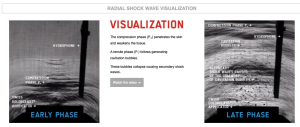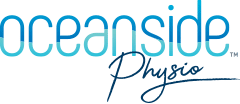Oceanside Physio uses the evidence-based Swiss DolorClast® Method of Radial Shockwave Therapy for most Musculoskeletal pathologies.
What is Shockwave Therapy?
Shock Waves are movements of extremely high pressure caused by, for example, an explosion, an earthquake or a plane breaking the sound barrier. Extracorporeal Shock Wave Therapy (ESWT) is the application of Shock Waves in medicine. A shock wave is a single acoustic pulse characterised by a rapid rise to a high peak pressure followed by a rapid drop to below ambient pressure. They are sent to the affected area from the point of contact on the skin’s surface using the device pictured above.
How does Shockwave Therapy work?
The Swiss DolorClast® Method uses single acoustic pressure waves to treat musculoskeletal pathologies.
The therapeutic effects of shock waves on the musculoskeletal system (pain relief and healing) are based on a multitude of molecular and cellular mechanisms. The short-term effects are depletion of presynaptic substance P in C nerve fibers (resulting in pain relief) & improved blood circulation in the treated area (which is the basis for healing). The long-term effects are blockade of neurogenic inflammation and improved tendon gliding ability (resulting in pain relief) as well as activation of mesenchymal stem cells and new bone formation (both essentially involved in healing).

t is clinically proven that pressure waves, when applied to injured tissues, stimulate metabolic reactions:
- Reduction of pain felt by nerve fibers
- Increase of blood circulation in surrounding soft tissues
- Beginning of healing process triggered by stem cells activation
What conditions can Shockwave treat?
- Neck and Back Pain
- Tendinopathies / Bursitis of the shoulder, hip, knee (patella), Achilles Tendon
- Plantar Fasciitis /fasciopathy with / without heel pain
- Patella Tip Syndrome
- Reduction of pain felt by nerve fibres
- Osgood-Schlatters disease
- Golfers and Tennis Elbow
- Osteoarthritis
- Non-union / delayed union of fractures
- Spasticity
Can anyone get Shockwave Therapy?
Shockwave therapy is not suitable for children under 18 (except for Osgood Schlatters disease), patients who take anti-coagulant medication (blood thinners such as Aspirin or Warfarin), patients with blood clotting disorders, local tumours or bacterial infection or anyone treated with local cortisone injections in the previous 6 weeks. Patients with Pacemaker or ICD require a doctor’s approval. prior to commencing treatment.
How is oceanside physio’s, The Swiss DolorClast® Method different to other Shockwave machines?
The superior engineering of the Swiss DolorClast machine delivers guaranteed constant energy delivery. This is essential in order to achieve the excellent patient outcomes noted in the research. The vast majority of research into Shockwave therapy has been performed using the The Swiss DolorClast® Method. It has been the Shockwave machine trusted by elite athletes across the world since the 90s & used at all Olympic Games since 2004.

References
1 Maier et al., Clin Orthop Relat Res 2003; (406):237–245.
2 In addition, shock waves activate the so-called Aδ nerve fibers (sensory afferent nerve fibers from the periphery) via receptors in the tissue.
According to Melzack and Wall’s gate control theory (Science 1965; 150:971–979) these activated Aδ fibers then suppress the conduction of pain in the second-order neuron of the sensory pathway in the dorsal horn of the spinal cord.
3 The release of substance P, CGRP (calcitonin gene-related peptide) and other inflammation mediators from afferent nerve fibers is generally referred to as “neurogenic inflammation” (Richardson and Vasko, J Pharmacol Exp Ther 2002; 302:839–845). It is also linked to the pathogenesis of tendinopathies such as tennis elbow and plantar fasciitis (Roetert et al., Clin Sports Med 1995; 14:47–57; LeMelle et al., Clin Podiatr Med Surg 1990; 7:385–389).Shock wave treatment causes a drop in substance P and CGRP in the tissue (Maier et al., 2003; Takahashi et al., Auton Neurosci 2003; 107:81–84).
4 Shock waves in the treated tissue lead to a stronger expression of growth factors such as BMP (bone morphogenetic protein), eNOS (endothelial nitric oxide synthase), VEGF (vascular endothelial growth factor) and PCNA (proliferating cell nuclear antigen) as well as to an activation of stem cells
(Wang CJ, ISMST Newsletter 2006, Vol. 1, Issue 1; Hofmann et al., J Trauma 2008; 65:1402–1410).
Book now
